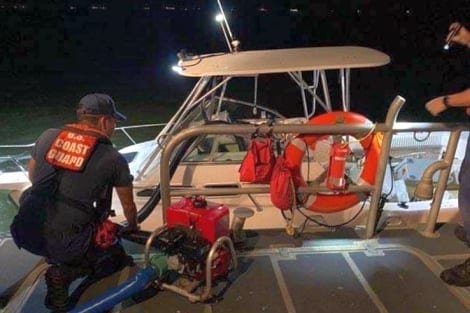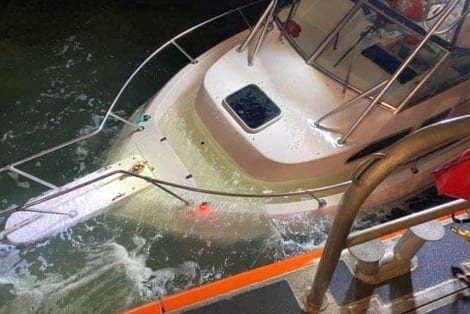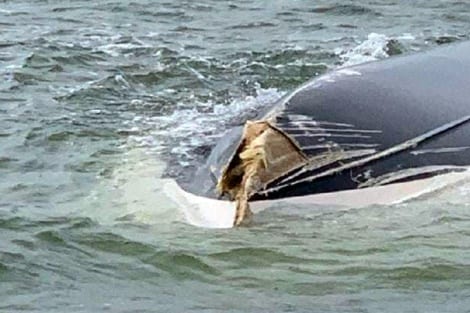 By Bob Currie, Recreational Boating Safety Specialist
By Bob Currie, Recreational Boating Safety Specialist
U. S. Coast Guard Auxiliary Base Galveston Flotilla
When a vessel make violent contact with an object in the water, and that contact causes damage to the vessel or the object that was struck, then the first question to be answered is whether the vessel and the struck object were both moving or whether one was stationary. If both objects were moving, the proper term for the accident is collision. If one object was stationary, then the proper term is allision. In many cases both a collision and an allision are between one vessel and another. Sometimes a collision can be between a moving vessel and another moving object such as a marine animal, while an allision can be between a moving vessel and a fixed object such as a jetty. In either case the Coast Guard is often called to respond to a vessel taking on water due to a collision or an allision.
The Base Galveston Flotilla of the US Coast Guard Auxiliary operates out of the US Coast Guard base on Galveston Island. They aid the Coast Guard by providing maritime observation patrols in Galveston Bay; by providing recreational boating vessel safety checks; and by working alongside Coast Guard members in maritime accident investigation, small boat training, providing a safety zone, Aids to Navigation verification, cooking in base and station galleys and aboard cutters, and on the Coast Guard Drone Team.
The pictures below are from a very recent allision where a recreational boat made violent contact with the Galveston jetties. Although the Coast Guard team that responded tried to save the vessel by pumping water from the hold, the damage was too severe and the vessel sank.

Coast Guard Station Galveston small boat crew pumps water from hold of a recreational boat that struck the Galveston jetty. USCG file photo.

As incoming water overcomes the Coast Guard deck pump the recreational vessel becomes swamped by water flowing over the gunwales. USCG file photo.

The swamped recreational boat finally capsizes, revealing the severe damage caused by striking the jetty. USCG file photo.
How to Keep This from Happening to You
The best way to avoid a collision or allision is to learn and follow the Rules of the Road, also known as the Navigation Rules. Knowing and following the rules listed below would certainly lower the risk of collision or allision for the prudent safe boater:
- Rule 5 – Look-Out
- Rule 6 – Safe Speed
- Rule 7 – Risk of Collision
- Rule 19 – Conduct of Vessels in Restricted Visibility
Rule 5 – Look-Out
The only position on a boat that is required by law is the lookout. Rule 5 of the Rules of the Road says that you must designate someone to watch for dangers that may come from any direction. “Every vessel shall at all times maintain a proper look-out by sight and hearing as well as by all available means appropriate in the prevailing circumstances and conditions so as to make a full appraisal of the situation and of the risk of collision.” Although you may have the latest electronic innovations such as GPS, radar, and infrared, your primary means of avoiding a collision remain your eyes and ears. That said, the rules also state that you must use all means available to avoid a collision, and that includes those electronic devices mentioned above. If you have operational radar aboard your boat, that radar must be utilized to help prevent a collision with another vessel. Rule 5 applies in all types of visibility, but you can see where it is most important when visibility is restricted. Hearing plays an enhanced part in a lookout’s job whenever visibility is restricted.
Rule 6: Safe Speed
Excessive speed was the number 5 contributing factor in recreational boating accidents. In 2018 there were 276 accidents involving excessive speed, with 25 deaths and 231 injuries reported. Operating at a safe speed becomes even more critical when visibility is restricted. Reducing your speed also reduces your engine noise, thus allowing you to better hear sound signals such as fog horns, whistles, and bells. Below is the wording of Rule 6:
Every vessel shall at all times proceed at a safe speed so that she can take proper and effective action to avoid collision and be stopped within a distance appropriate to the prevailing circumstances and conditions. In determining a safe speed the following factors shall be among those taken into account:
(a) By all vessels:
(i) The state of visibility;
(ii) The traffic density including concentrations of fishing vessels or any other vessels;
(iii) The maneuverability of the vessel with special reference to stopping distance and turning ability in the prevailing conditions;
(iv) At night, the presence of background light such as from shore lights or from back scatter from her own lights;
(v) The state of wind, sea and current, and the proximity of navigational hazards;
(vi) The draft in relation to the available depth of water.
(b) Additionally, by vessels with operational radar:
(i) The characteristics, efficiency and limitations of the radar equipment;
(ii) Any constraints imposed by the radar range scale in use;
(iii) The effect on radar detection of the sea state, weather and other sources of interference;
(iv) The possibility that small vessels, ice and other floating objects may not be detected by radar at an adequate range;
(v) The number, location and movement of vessels detected by radar;
(vi) The more exact assessment of the visibility that may be possible when radar is used to determine the range of vessels or other objects in the vicinity.
Rule 7: Risk of Collision
Rule 7 comes into play whenever another vessel is detected, whether by sight, hearing, Automatic Identification System (AIS), or radar. Below is the wording of the rule:
(a) Every vessel shall use all available means appropriate to the prevailing circumstances and conditions to determine if risk of collision exists. If there is any doubt such risk shall be deemed to exist.
(b) Proper use shall be made of radar equipment if fitted and operational, including long-range scanning to obtain early warning of risk of collision and radar plotting or equivalent systematic observation of detected objects.
(c) Assumptions shall not be made on the basis of scanty information, especially scanty radar information.
(d) In determining if risk of collision exists the following considerations shall be among those taken into account:
(i) Such risk shall be deemed to exist if the compass bearing of an approaching vessel does not appreciably change.
(ii) Such risk may sometimes exist even when an appreciable bearing change is evident, particularly when approaching a very large vessel or a tow or when approaching a vessel at close range.
As you can see from this rule, just detecting an object is not enough; you must plot an object’s course to determine if a risk of collision exists early enough to alter course if necessary to avoid a collision.
Rule 19 – Conduct of Vessels in Restricted Visibility
Rule 19 of the Rules of the Road says that, first, “every vessel shall proceed at a safe speed adapted to the prevailing circumstances and conditions of restricted visibility.” Isn’t that interesting that the rules say that the most important consideration for seeing and being seen is your speed? Another way of saying this is, “If you hit something with your boat then you were going too fast.”
Rule 19 also discusses the use of radar and hearing when operating in restricted visibility.
Summary
Whether it is the risk of collision with another vessel underway or allision with a fixed object, the prudent mariner will follow the Rules of the Road to avoid such circumstances. The most important things you can do to prevent collision or allision are to post a proper look-out and operate at a speed that is safe for the present conditions. Be sure to ensure that you have the required visual distress signals, and make sure you have a means of contacting the Coast Guard in an emergency. There is no phone booth on the jetties.
For more information on boating safety, please visit the Official Website of the U.S. Coast Guard’s Boating Safety Division at www.uscgboating.org. Questions about the US Coast Guard Auxiliary or our free Vessel Safety Check program may be directed to me at [email protected]. SAFE BOATING!
[Nov-23-2020]

 Posted in
Posted in 























